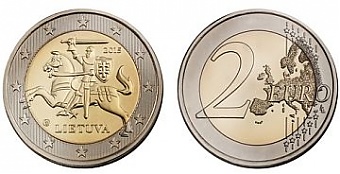Banks, EU – Baltic States, Financial Services, Lithuania
International Internet Magazine. Baltic States news & analytics
Friday, 05.12.2025, 08:56
2015 Lithuanian euro coin samples have been minted
 Print version
Print version |
|---|
"The euro in Lithuania is taking an actual physical form – the Lithuanian coins with the 2015 date now exist not only on paper, but have been minted from metal as well. The circulation euro coin samples are high quality examples of coins – they will be the basis for the coins jingling in the purses of the Lithuanian population," says Vitas Vasiliauskas, Chairman of the Board of the Bank of Lithuania.
According to him, mass-minting of the Lithuanian euro coins is planned for the end of summer, when the decision of the Council of the European Union, regarding the euro adoption in Lithuania, will be announced. Until then, small amounts of test sample coins may be minted, seeking to test the coin blanks, minting tools and the coin measuring-control equipment. The overall demand for Lithuanian euro coins is around 370 million units.
The national side of the Lithuanian circulation euro coins was designed by the sculptor Antanas Zukauskas. The Board of the Bank of Lithuania has three different designs for the national side (obverse). They depict the symbol from the emblem of the Lithuanian State – Vytis, and it is surrounded by the inscriptions LIETUVA (Lithuania), 2015 and twelve stars: on one and two euro coins – a background of vertical lines; the 10, 20 and 50 euro cent coins – horizontal lines; on one, two and five euro cent coins – a plain surface.
The edge of the Lithuanian two euro coin bears the inscription: LAISVE, VIENYBE, GEROVE (Freedom, Unity, Well-Being).
The circulation euro and euro cent coins with the Vytis will be minted in Vilnius by UAB Lithuanian Mint. The 1 and 2 euro coins will be dual coloured, minted from coloured metal alloys; the 10, 20, 50 euro cent coins – from the so-called 'Nordic gold' alloy; the one, two and five euro cent coins – from copper coated steel. Every state, which has adopted the euro, has the right to issue euro coins of which one side is the same for all countries (common side) and the other is different (national side). According to surveys, almost 70 per cent of the population positively evaluate the Vytis on the Lithuanian euro coins. Lithuania aims to adopt the euro from January 1, 2015.








 «The Baltic Course» Is Sold and Stays in Business!
«The Baltic Course» Is Sold and Stays in Business!

